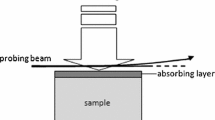Abstract
A comparative analysis of the electrical conductivity of whisker, epitaxial film, and single crystal of tellurium was undertaken in the 77–273 K temperature range. The electrical conductivity of the film and single crystal increases monotonically up to 200 K, after which it begins to rise steeply, corresponding to the thermal excitation of intrinsic carriers. The electrical conductivity of whiskers decreases with increasing temperature to 230 K, after which it begins to increase more gradually. It is assumed that in the case of tellurium whiskers, the classical size effect takes place: the decrease in electrical conductivity is due to diffuse scattering of carriers by the lateral surface of the crystal of tellurium and is intensified with increasing temperature. The uneven, tightly-convoluted surface of developed samples is shown in images produced in a scanning electron microscope in the nanometer range.






Similar content being viewed by others
REFERENCES
P. Grosse, Die Festkörper Eigenschaften von Tellur, Springer Tracts in Modern Physics (Springer, Berlin, 1969).
I. Shih and C. H. Champness, J. Cryst. Growth 44, 492 (1978).
R. V. Parfen’ev, I. I. Farbshtein, I. L. Shul’pina, S. V. Yakimov, V. P. Shalimov, and A. M. Turchaninov, Phys. Solid State 44, 1241 (2002).
M. J. Capers and M. White, Thin Solid Films 8, 353 (1971).
T. Hristova-Vasileva, I. Bineva, R. Todorov, A. Dinescu, and C. Romanitan, in Proceedings of the 20th International School on Condensed Matter Physics, Russia, 2019 (2019), p. 1186.
M. S. Bresler, V. G. Veselago, Yu. V. Kosichkin, G. E. Pikus, I. I. Farbshtein, and S. S. Shalyt, Sov. Phys. JETP 30, 799 (1969).
S. Tutihasi, S. G. Roberts, R. S. Keeres, and R. E. Drens, Phys. Rev. 177 (3), 1143 (1969).
R. Viswanathan, R. Balasubramanian, D. Darwin Albert Raj, M. Sai Baba, and T. S. Lakshmi Narasimhan, J. Alloys Compd. 603, 75 (2014).
H. Zhen, Y. Yuan, L. Jian-Wei, and Y. Shu-Hong, Chem. Soc. Rev. 46, 2732 (2017).
K. R. Sapkota, P. Lu, L. D. Medlin, and G. T. Wang, APL Mater. 7, 081103 (2019).
P. Yuanyuan and G. Shiyuan, Li Yang, and Lu Jing, Phys. Rev. 98, 085135 (2018).
Z. Zhili, C. Xiaolin, Y. Seho, C. Jinglei, D. Yawei, N. Chunyao, G. Zhengxiao, X. Maohai, L. Feng, C. Jun-Hyung, Yu Jia, and Z. Zhenyu, Phys. Rev. Lett. 119, 106101 (2017).
Wu Wenzhuo, Q. Gang, W. Yixiu, W. Ruoxing, and Y. Peide, Chem. Soc. Rev. 47, 7203 (2018).
W. Dawei, Y. Aijun, L. Tiansong, F. Chengyu, P. Jianbin, Liu Zhu, Chu Jifeng, Y. Huan, W. Xiaohua, R. Mingzhe, and K. Nikhil, J. Mater. Chem. A 10, 1039 (2019).
S. Chenfei, L. Yihang, W. Jiangbin, X. Chi, C. Dingzhou, L. Zhen, L. Qingzhou, L. Yuanrui, W. Yixiu, C. Xuan, K. Hiroyuki, Sh. Fuyuki, K. Aravind, K. Rajiv, N. Aiichiro, D. Priya, R. A. Vashishta, Mor, N. Ahmad, H. W. Abbas, W. Wenzhuo, and Z. Chongwu, ACS Nano 14, 303 (2020).
A. M. Ismailov, I. M. Shapiev, M. Kh. Rabadanov, and I. Sh. Aliev, Tech. Phys. Lett. 41, 83 (2015).
W. Xiao Ping, L. Yuan, Sh. Min Zhou, Sh. Yun Lou, Y. Qiang Wang, T. Gao, Y. Biao Liu, and X. Jing Shi, Nanopart. Res. 14, 1009 (2012).
T. Il Lee, S. Lee, E. Lee, S. Sohn, Y. Lee, S. Lee, G. Moon, D. Kim, Y. Sang Kim, J. Min Myoung, and Z. Lin Wang, Adv. Mater. 25, 2920 (2013).
R. W. Dutton and R. S. Muller, Proc. IEEE 59, 1511 (1971).
R. V. Parfen’ev, Kogarskii, I. I. Farbshtein, and S. S. Shalyt, Sov. Phys. Solid State 3, 1820 (1961).
N. Chaudhuri, Indian J. Pure Appl. Phys. 3, 50 (1965).
J. M. Ziman, Electrons and Phonons (Oxford Univ., Oxford, 1960).
M. Green, Solid State Surface Science (Marcel Dekker, New York, 1969).
K. Fucks, Proc. Cambridge Phil. Soc. 34, 100 (1938).
Yu. P. Gaidukov, Sov. Phys. Usp. 27, 256 (1984).
Funding
This work was supported by RFBR project no. 18-02-00808A.
Author information
Authors and Affiliations
Corresponding author
Ethics declarations
The authors declare that they have no conflict of interest.
Rights and permissions
About this article
Cite this article
Rabadanov, M.R., Stepurenko, A.A., Gummetov, A.E. et al. Temperature Dependence of the Conductivity of Tellurium Whiskers. Semiconductors 55, 551–556 (2021). https://doi.org/10.1134/S1063782621060129
Received:
Revised:
Accepted:
Published:
Issue Date:
DOI: https://doi.org/10.1134/S1063782621060129




